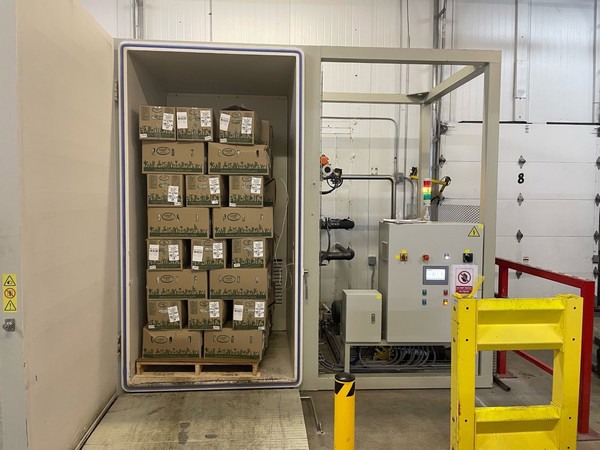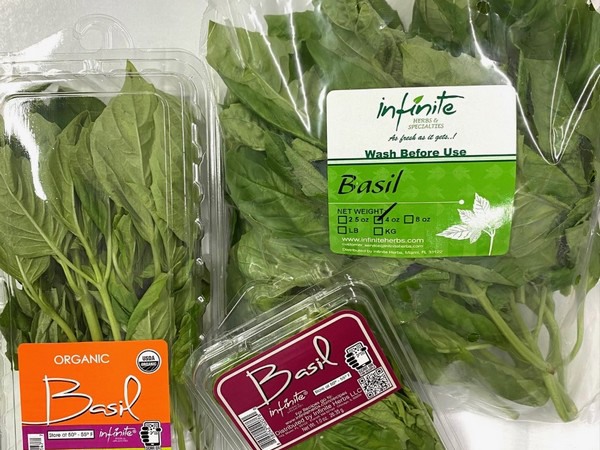Keeping the cold chain intact is always critical when transporting produce. But it may be particularly more important in moving herbs.
“Herbs are a highly perishable item with a very short life. The way you manage the cold chain directly impacts the quality and shelf life of the herb,” says Grego Berliavsky of Miami, Florida-based Infinite Herbs & Specialties. Which is why, after seeing how successful the vacuum cooling system was proving to be within Colombia’s Agroaromas SAS, which supplies the majority of its herbs, Infinite Herbs installed a similar system in its Miami facility in February.
For Infinite Herbs, the new system was put in place to remove the moisture or “perspire” of the herbs once harvested. The herbs enter the cooling system and then the temperature is lowered as is the atmospheric pressure. At that point, water surrounding the herb evaporates and the temperature drops from anywhere from 50-60 degrees Fahrenheit to 34-36 degrees which puts the herbs to “sleep”. “When you take them out, not only did you cool the herbs but you also dried them and that’s key. That’s what’s going to let you increase the shelf life,” says Berliavsky.

Modifying pressure
The system was also a fully natural one. “You’re not injecting any type of gas or anything into the package. This is just a natural process where it modifies the atmospheric pressure inside the chamber,” Berliavsky says. But it’s a balance because while moisture needs to be removed, the system is calibrated so that it also doesn’t dehydrate the fresh herb product.
And while it treats all of its herbs this way…then there’s basil. “Basil is a completely different animal in that it doesn’t like the cold. If you go below 45 degrees, it can burn so the ideal temperature for basil is between 50-55 degrees,” says Berliavsky, noting basil could even go up to 60 degrees and it won’t start “perspiring.” In turn, basil requires its own settings that the machine only cools to 50 degrees and then it stops. “It’s cooling but it’s really taking out as much of the condensation as possible. It’s the real headache for our industry because it’s an herb that’s consumed the most but it’s also the most delicate and the hardest to manage,” he says.
Meanwhile chives are the most delicate herb of the bunch given there are no leaves or stems intact. “So once it goes higher than 38-40 degrees, it’s going to turn yellow and mushy,” says Berliavsky.
Infinite Herbs in fact uses the vacuum cooling system twice on its herbs--once in Colombia where 60 percent of its herbs are grown in a number of different climates and altitudes. And then once again when it arrives in Miami, the hub where all its herb imports are received.

Managing fluctuations
That’s largely because of the fluctuations in temperature that the herbs potentially feel in their travels. “Because the herbs are brought in by air, and even though cargo planes have a good temperature during the trip, just the handling and moving them from a cold room to a runway and then into Miami where for 10 months of the year it’s 85 degrees--those changes in temperature affect the herbs greatly,” says Berliavsky.
He notes ideally such a vacuum cooling system would be implemented in every stop--however costs prohibit such a step so Infinite Herbs remains confident that the two vacuum cooling stops work well for now.
As for the success? Berliavsky estimates shelf life on Infinite herbs is extended by three to five days on its herb products thanks to this newly implemented system. It’s also proven so successful that it’s introduced the system for its flowers as well.
“It’s all very easy to use and to set up and we saw the difference right away” says Berliavsky. “Now I’m trying to use it 24 hours a day to get the most out of it.”
 For more information:
For more information:
Sylvia van Uden
WeberCooling
email: svu@webercooling.com
www.webercooling.com
M: + 31612819917
